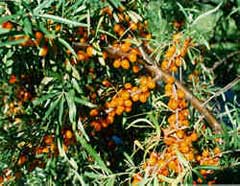Plant portrait - Hippophae salicifolia
 When we first moved to Cornwall, one of the first plants I put out was a small group of Hippophae salicifolia. They were about 60cm tall and looked rather lost in the middle of this large empty field. A month later, the rabbits had done their worst and each of the plants had lost most of their bark. I thought that this was the death-knell for them, but put some protection around them just in case.
When we first moved to Cornwall, one of the first plants I put out was a small group of Hippophae salicifolia. They were about 60cm tall and looked rather lost in the middle of this large empty field. A month later, the rabbits had done their worst and each of the plants had lost most of their bark. I thought that this was the death-knell for them, but put some protection around them just in case.
Along came the spring and the plants grew away as though nothing had happened to them. By the end of their first summer they were about 1.5 metres tall and looking wonderful. They have managed to keep up this same rate of growth in subsequent years and the largest is now over 6 metres tall and really looking like a tree. The plants have been impervious to the frequent strong winds we get here and have also been unaffected by droughts or exceedingly wet weather.
They also look quite beautiful. Of a very uptight habit, their deciduous leaves have a somewhat silvery hue and look rather like the leaves of a willow tree. They fruited for the first time this year. Two of the three plants have turned out to be female and the other is a male (what wonderful luck) and one of the females had a particularly heavy crop.
The fruit is rather small, about 3mm in diameter, and is very fiddly to harvest. It is carried right next to the branches and these branches are often armed with large thorns. The fruit itself tastes like a sharp lemon, which is not to everyone's taste raw. Our 16 month old son loved it and ate it in quantity. He was frequently asking us to pick it for him. If you cannot stomach much of it raw, the fruit makes a superb juice or can be cooked to make jams and other preserves. What makes this fruit rather special is that it is quite possibly the most nutritious fruit that can be grown outdoors in Britain. It is very rich in vitamins (especially C) and minerals and also contains essential fatty acids. These fatty acids have been shown to prevent cancer when taken as part of the diet and experiments in Sweden are indicating that they can be used in treating cancer. A superb lotion for treating burns can be made from the fruits and also from the young twigs. This lotion is said to prevent scarring.
The tree is very vigorous and also enriches the soil with nitrogen. It has a very vigorous root system and has been planted on steep slopes to stabilize the soil. It also produces suckers freely so is not a plant to grow in a small space. If you have room for it, however, then it is a very worthwhile plant to grow. It needs a position in a well-drained soil with at least a reasonable amount of sun, but apart from that it is not really fussy.
Database
The database has more details on these plants: Hippophae salicifolia.